The Frozen Tissues Samples Market is estimated to be valued at USD 1.6 billion in 2025 and is projected to reach USD 3.3 billion by 2035, registering a compound annual growth rate (CAGR) of 7.5% over the forecast period.
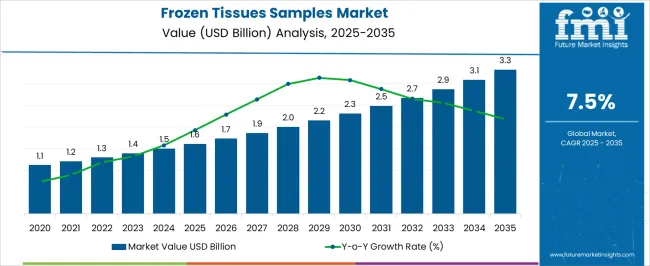
| Metric | Value |
|---|---|
| Frozen Tissues Samples Market Estimated Value in (2025 E) | USD 1.6 billion |
| Frozen Tissues Samples Market Forecast Value in (2035 F) | USD 3.3 billion |
| Forecast CAGR (2025 to 2035) | 7.5% |
The Frozen Tissues Samples market is witnessing steady growth driven by the increasing demand for high-quality biological specimens in research and clinical applications. The current market scenario reflects strong adoption across academic, clinical, and industrial laboratories where tissue preservation is critical for downstream molecular analysis, biomarker discovery, and translational research.
Advancements in cryopreservation techniques and cold chain logistics have enhanced the integrity and longevity of samples, making frozen tissues an essential resource for reproducible and accurate experimental outcomes. Rising investments in cancer research, personalized medicine, and genomics are further supporting market expansion, while regulatory guidelines around sample storage and biobanking are reinforcing standardized practices.
The growing focus on early disease detection, development of targeted therapeutics, and adoption of multicenter research studies is creating opportunities for scalable storage and distribution solutions As research institutions continue to prioritize high-fidelity samples for molecular diagnostics and drug development, the frozen tissues samples market is expected to sustain its growth trajectory, driven by innovation in preservation technologies and expanding research infrastructure globally.
The frozen tissues samples market is segmented by product type, application, end user, and geographic regions. By product type, frozen tissues samples market is divided into Frozen Tumor Tissue Samples, Frozen Normal Tissue Samples, Frozen Diseased Tissue Samples, Fresh Frozen Tissue Samples, and Formalin-Fixed Paraffin-Embedded Tissues.
In terms of application, frozen tissues samples market is classified into Cancer Research, Disease Diagnosis, and Morphological Analysis. Based on end user, frozen tissues samples market is segmented into Academic & Research Institutes, Banks, Hospitals & Clinics, Diagnostic Centers, Forensic Laboratories, and Others.
Regionally, the frozen tissues samples industry is classified into North America, Latin America, Western Europe, Eastern Europe, Balkan & Baltic Countries, Russia & Belarus, Central Asia, East Asia, South Asia & Pacific, and the Middle East & Africa.
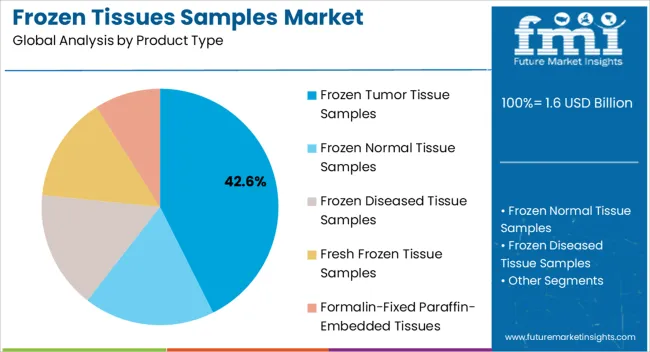
Frozen Tumor Tissue Samples are projected to hold 42.6% of the Frozen Tissues Samples market revenue in 2025, making them the leading product type. This dominance has been driven by their crucial role in cancer research and therapeutic development, where preservation of tumor morphology and molecular integrity is essential for accurate biomarker identification and drug screening.
The growth of this segment is supported by the increasing prevalence of oncology research, higher adoption of biobanking for tumor specimens, and the need for reliable samples for multi-omics studies. Frozen tumor tissues enable long-term storage without significant degradation, which is critical for longitudinal studies and reproducibility of experimental results.
Laboratories are increasingly preferring frozen tumor specimens due to their compatibility with high-throughput assays and advanced molecular techniques The ability to maintain protein, DNA, and RNA integrity over extended periods without chemical fixation has further reinforced the segment’s adoption, positioning it as a key contributor to market revenue.
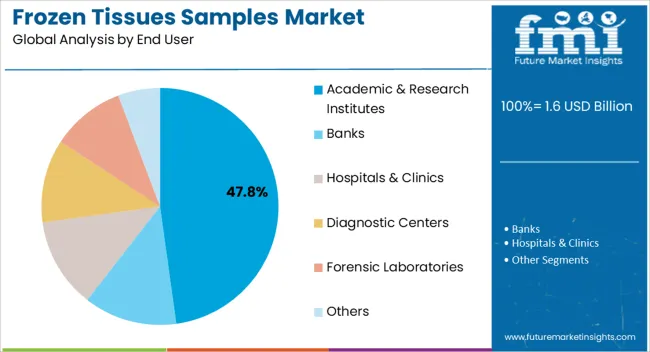
The Cancer Research application segment is expected to account for 35.0% of the Frozen Tissues Samples market revenue in 2025, establishing it as the leading application area. This is largely attributed to the growing global focus on oncology research, early detection programs, and precision medicine initiatives. Frozen tissues provide an essential resource for experimental validation of biomarkers, drug efficacy studies, and genetic profiling of tumors.
Adoption has been driven by the ability of frozen specimens to retain high molecular fidelity, enabling accurate cellular and molecular analyses across various platforms. Increasing investments by research institutions and private entities in oncology programs have resulted in a higher demand for preserved tissue samples.
Moreover, the integration of biobanking networks and centralized tissue repositories has facilitated easier access to high-quality samples for collaborative research The sustained demand for frozen tissues in cancer research is expected to continue, as institutions prioritize robust, reproducible, and scalable research workflows to support innovation in cancer therapeutics and diagnostics.
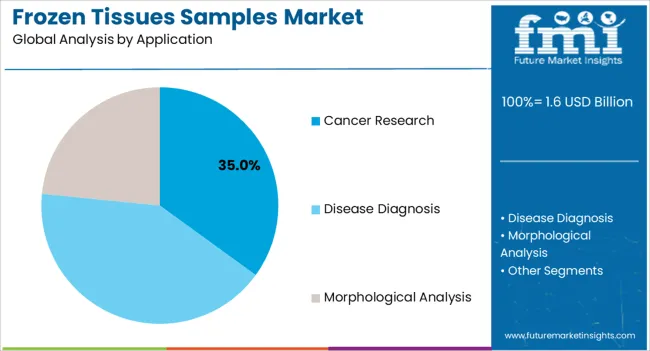
The Academic & Research Institutes segment is anticipated to hold 47.8% of the Frozen Tissues Samples market revenue in 2025, making it the leading end user. This dominance is being driven by the extensive use of frozen tissues in molecular biology, pathology, and translational research programs conducted in universities and research centers.
Frozen samples allow researchers to perform high-fidelity analyses of genes, proteins, and metabolites while maintaining sample integrity over time, which is critical for experimental reproducibility and longitudinal studies. The growth of this segment is further supported by expanding research funding, increased emphasis on publication quality, and the need for standardized tissue resources for collaborative projects.
Academic and research institutes are also investing in infrastructure for biobanking and cold storage systems, ensuring reliable preservation and accessibility of samples As the demand for high-quality biological specimens continues to rise, these institutions remain the primary consumers of frozen tissue samples, leveraging them to advance fundamental and applied research while supporting innovation in disease modeling, diagnostics, and therapeutic development.
Frozen tissues samples play a very important role for molecular genetic analysis. Frozen tissue sample manufacturers are leveraging on new technologies to bring more stability to their products after cryopreservation. One of such new methods applied in preserving frozen tissues samples is dipping in liquid nitrogen. Nowadays, key players are also employing an ultra-cold freezer containing temperature less than -80 degrees Celsius to increase lifespan to the product. In addition, microarrays based frozen tissues samples are also manufactured by culturing cells to obtain many primary frozen tissues. The key players in the market are investing huge in cryopreservation so that these frozen tissues samples are very useful for immunohistochemistry analysis of proteins, which are also preserved in a native state. Recent advancement in freezing technologies and tissue preservation is making the frozen tissues samples market to grow in the future.
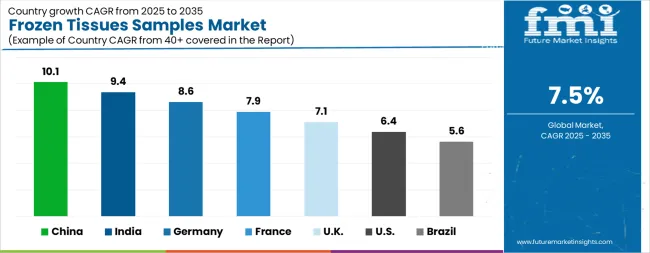
| Country | CAGR |
|---|---|
| China | 10.1% |
| India | 9.4% |
| Germany | 8.6% |
| France | 7.9% |
| UK | 7.1% |
| USA | 6.4% |
| Brazil | 5.6% |
The Frozen Tissues Samples Market is expected to register a CAGR of 7.5% during the forecast period, exhibiting varied country level momentum. China leads with the highest CAGR of 10.1%, followed by India at 9.4%. Developed markets such as Germany, France, and the UK continue to expand steadily, while the USA is likely to grow at consistent rates.
Brazil posts the lowest CAGR at 5.6%, yet still underscores a broadly positive trajectory for the global Frozen Tissues Samples Market. In 2024, Germany held a dominant revenue in the Western Europe market and is expected to grow with a CAGR of 8.6%.
The USA Frozen Tissues Samples Market is estimated to be valued at USD 606.8 million in 2025 and is anticipated to reach a valuation of USD 1.1 billion by 2035. Sales are projected to rise at a CAGR of 6.4% over the forecast period between 2025 and 2035. While Japan and South Korea markets are estimated to be valued at USD 78.3 million and USD 53.1 million respectively in 2025.
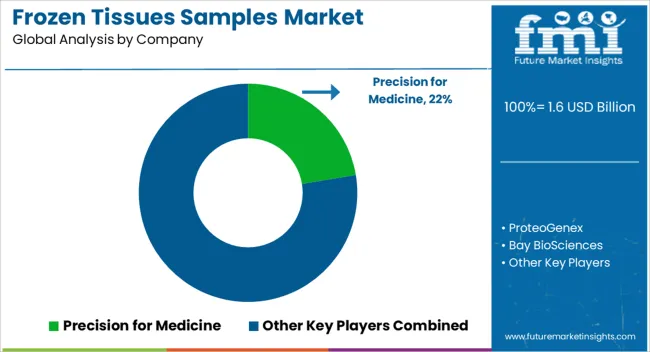
| Item | Value |
|---|---|
| Quantitative Units | USD 1.6 Billion |
| Product Type | Frozen Tumor Tissue Samples, Frozen Normal Tissue Samples, Frozen Diseased Tissue Samples, Fresh Frozen Tissue Samples, and Formalin-Fixed Paraffin-Embedded Tissues |
| Application | Cancer Research, Disease Diagnosis, and Morphological Analysis |
| End User | Academic & Research Institutes, Banks, Hospitals & Clinics, Diagnostic Centers, Forensic Laboratories, and Others |
| Regions Covered | North America, Europe, Asia-Pacific, Latin America, Middle East & Africa |
| Country Covered | United States, Canada, Germany, France, United Kingdom, China, Japan, India, Brazil, South Africa |
| Key Companies Profiled | Precision for Medicine, ProteoGenex, Bay BioSciences, Zen-Bio, OriGene Technologies, AMS Biotechnology (Europe), REPROCELL, US Biolab Corporation, BioChain Institute, and Geneticist |
The global frozen tissues samples market is estimated to be valued at USD 1.6 billion in 2025.
The market size for the frozen tissues samples market is projected to reach USD 3.3 billion by 2035.
The frozen tissues samples market is expected to grow at a 7.5% CAGR between 2025 and 2035.
The key product types in frozen tissues samples market are frozen tumor tissue samples, frozen normal tissue samples, frozen diseased tissue samples, fresh frozen tissue samples and formalin-fixed paraffin-embedded tissues.
In terms of application, cancer research segment to command 35.0% share in the frozen tissues samples market in 2025.






Our Research Products

The "Full Research Suite" delivers actionable market intel, deep dives on markets or technologies, so clients act faster, cut risk, and unlock growth.

The Leaderboard benchmarks and ranks top vendors, classifying them as Established Leaders, Leading Challengers, or Disruptors & Challengers.

Locates where complements amplify value and substitutes erode it, forecasting net impact by horizon

We deliver granular, decision-grade intel: market sizing, 5-year forecasts, pricing, adoption, usage, revenue, and operational KPIs—plus competitor tracking, regulation, and value chains—across 60 countries broadly.

Spot the shifts before they hit your P&L. We track inflection points, adoption curves, pricing moves, and ecosystem plays to show where demand is heading, why it is changing, and what to do next across high-growth markets and disruptive tech

Real-time reads of user behavior. We track shifting priorities, perceptions of today’s and next-gen services, and provider experience, then pace how fast tech moves from trial to adoption, blending buyer, consumer, and channel inputs with social signals (#WhySwitch, #UX).

Partner with our analyst team to build a custom report designed around your business priorities. From analysing market trends to assessing competitors or crafting bespoke datasets, we tailor insights to your needs.
Supplier Intelligence
Discovery & Profiling
Capacity & Footprint
Performance & Risk
Compliance & Governance
Commercial Readiness
Who Supplies Whom
Scorecards & Shortlists
Playbooks & Docs
Category Intelligence
Definition & Scope
Demand & Use Cases
Cost Drivers
Market Structure
Supply Chain Map
Trade & Policy
Operating Norms
Deliverables
Buyer Intelligence
Account Basics
Spend & Scope
Procurement Model
Vendor Requirements
Terms & Policies
Entry Strategy
Pain Points & Triggers
Outputs
Pricing Analysis
Benchmarks
Trends
Should-Cost
Indexation
Landed Cost
Commercial Terms
Deliverables
Brand Analysis
Positioning & Value Prop
Share & Presence
Customer Evidence
Go-to-Market
Digital & Reputation
Compliance & Trust
KPIs & Gaps
Outputs
Full Research Suite comprises of:
Market outlook & trends analysis
Interviews & case studies
Strategic recommendations
Vendor profiles & capabilities analysis
5-year forecasts
8 regions and 60+ country-level data splits
Market segment data splits
12 months of continuous data updates
DELIVERED AS:
PDF EXCEL ONLINE
Frozen Pet Food Market Size and Share Forecast Outlook 2025 to 2035
Frozen Yogurt Market Size and Share Forecast Outlook 2025 to 2035
Frozen Egg Market Size and Share Forecast Outlook 2025 to 2035
Frozen Food Packaging Market Size and Share Forecast Outlook 2025 to 2035
Frozen Food Packaging Machines Market Size and Share Forecast Outlook 2025 to 2035
Frozen Food Market Analysis - Size, Share, and Forecast Outlook 2025 to 2035
Frozen Pastries Market Size and Share Forecast Outlook 2025 to 2035
Frozen Baked Goods Market Size and Share Forecast Outlook 2025 to 2035
Frozen Potatoes Market Size and Share Forecast Outlook 2025 to 2035
Frozen Beverage Dispenser Market Size and Share Forecast Outlook 2025 to 2035
Frozen Meat Grinder Market Size and Share Forecast Outlook 2025 to 2035
Frozen Fruits and Vegetables Market Size and Share Forecast Outlook 2025 to 2035
Frozen Vegetable Market Analysis - Size, Share, and Forecast Outlook 2025 to 2035
Frozen Cheese Market Size and Share Forecast Outlook 2025 to 2035
Frozen Snacks Market Analysis - Size, Share, and Forecast Outlook for 2025 to 2035
Frozen Fruit Bars Market Analysis - Size and Share Forecast Outlook 2025 to 2035
Frozen Desserts Market Growth Share Trends 2025 to 2035
Frozen Ready Meals Market Analysis - Size, Share, and Forecast Outlook 2025 to 2035
Frozen Tortilla Market Size, Growth, and Forecast for 2025 to 2035
Market Share Insights in the Frozen Food Industry

Thank you!
You will receive an email from our Business Development Manager. Please be sure to check your SPAM/JUNK folder too.
Chat With
MaRIA